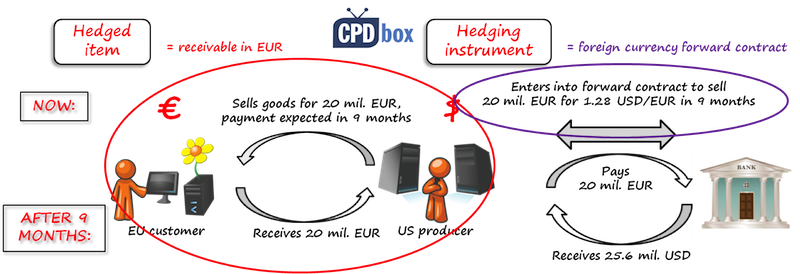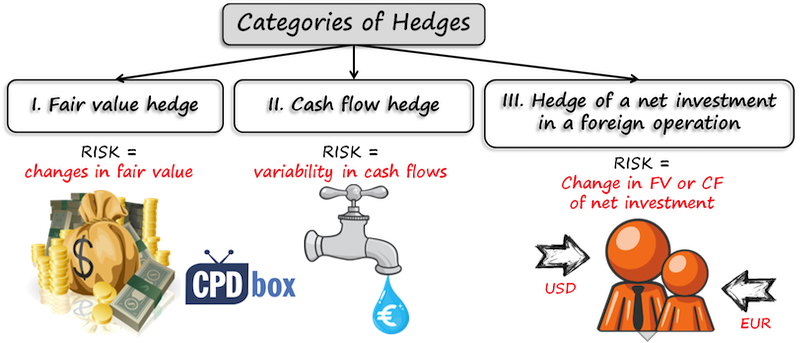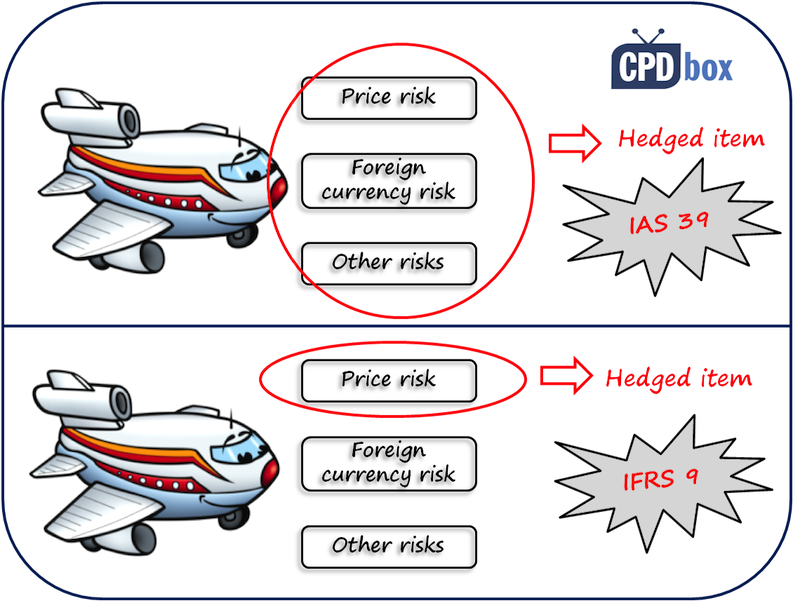Hedge Accounting: IAS 39 vs. IFRS 9
Business world as of today presents a huge amount of various risks to almost every company or entrepreneur. I’m sure that also your company faces at least some of these risks: foreign currency risk, price risk, inflation risk, credit risk – just name it.
Many businesses decided to do something about these risks and started to manage their exposures. How?
They undertake various risk management strategies. In most cases, companies acquire certain derivatives or other instruments to protect themselves.
What is a hedging?
A hedging is making an investment or acquiring some derivative or non-derivative instruments in order to offset potential losses (or gains) that may be incurred on some items as a result of particular risk.
Example of a hedge
As an example, imagine your company that normally operates is USD. Recently, your company has decided to spread its business to Europe and made a contract to sell some goods to European customer for let’s say 20 million EUR with delivery in 9 months.
However, your company is afraid that due to movements in foreign currency rates it will get significantly less USD after 9 months and therefore, it enters into offsetting foreign currency forward contract with bank to sell 20 mil. EUR for some fixed rate after 9 months.
What’s the hedge here?
Hedged risk is a foreign currency risk.
Hedged item is a highly probable forecast transaction (sale).
Hedging instrument is a foreign currency forward contract to sell EUR for a fixed rate at a fixed date.

What is a hedge accounting?
A hedge accounting means designating one or more hedging instruments so that their change in fair value offsets the change in fair value or the change in cash flows of a hedged item.
Let’s explain it on our example: how would you account for a change in fair value of the above foreign currency forward?
Without hedge accounting, any gain or loss resulting from the change in fair value of foreign currency forward would be recognized directly to profit or loss.

With hedge accounting, this hedge would be accounted for as a cash flow hedge. It means that you would recognize full or a part of gain or loss from foreign currency forward directly to equity (other comprehensive income).

As you can see, the impact of the same foreign currency forward contract on profit or loss statement with hedge accounting can be significantly lower than without it.
Why hedge accounting?
First of all, hedge accounting is NOT mandatory. It is optional, so you can select not to follow it and recognize all gains or losses from your hedging instruments to profit or loss.
However, when you apply hedge accounting, you show to the readers of your financial statements:
- That your company faces certain risks.
- That you perform certain risk management strategies in order to mitigate those risks.
- How effective these strategies are.
In fact, with hedge accounting, your profit and loss statement is less volatile, because you basically match these gains and losses with gains / losses on your hedged item.
Why do hedge accounting rules change?
Hedge accounting rules in IAS 39 are just too complex and strict. Many companies that actively pursued hedging strategies could not apply hedge accounting in line with IAS 39 because the rules did not allow it.
Therefore, investors often required preparation of non-audited “pro-forma” information. Thus a company’s accountants might have ended with a task to prepare 2 sets of financial statements:
- Audited financial statements where no hedge accounting was applied due to not meeting the rules in IAS 39.
- Non-audited, pro-forma financial statements with applied hedge accounting to reflect true risk management situation.
As a result, new hedging rules in IFRS 9 were issued on 19 November 2013.
What do IAS 39 and IFRS 9 have in common?
There are several major points that remained almost the same:
-
- Optional
A hedge accounting is an option, not an obligation – both in line with IAS 39 and IFRS 9. - Terminology
Both standards use the same most important terms: hedged item, hedging instrument, fair value hedge, cash flow hedge, hedge effectiveness, etc. - Hedge documentation
Both IAS 39 and IFRS 9 require hedge documentation in order to qualify for a hedge accounting. - Categories of hedges
Both IAS 39 and IFRS 9 arrange the hedge accounting for the same categories: fair value hedge, cash flow hedge and net investment hedge. The mechanics of the hedge accounting is basically the same.
- Optional

- Hedge ineffectiveness
Both IAS 39 and IFRS 9 require accounting for any hedge ineffectiveness in profit or loss. There is an exception related to hedge of equity investment designated at fair value through other comprehensive income in line with IFRS 9: all hedge ineffectiveness is recognized to other comprehensive income. - No written options
You cannot use written options as a hedging instrument in line with both IAS 39 and IFRS 9.
Differences in hedge accounting between IAS 39 and IFRS 9
The basics of hedge accounting have not changed. In my opinion the major change lies in widening the range of situations to which you can apply hedge accounting.
In other words, under new IFRS 9 rules, you can apply hedge accounting to more situations as before because the rules are more practical, principle based and less strict.
Let’s go through the most important changes:
- What can be used as a hedging instrumentUnder older rules in IAS 39, companies did not have much choices of hedging instruments. Either they took some derivatives, or alternatively they could take also non-derivative financial asset or liability in a hedge of a foreign currency risk. Not much.IFRS 9 allows you to use broader range of hedging instruments, so now you can use any non-derivative financial asset or liability measured at fair value through profit or loss.
Example: Let’s say you have large inventories of crude oil and you would like to hedge their fair value. Therefore you make an investment into some fund with portfolio of commodity – linked instruments.
In line with IAS 39, you cannot apply hedge accounting, because in a fair value hedge, you can use only some derivative as your hedging instrument.
In line with IFRS 9, you can apply hedge accounting, because IFRS 9 allows designating also non-derivative financial instrument measured at fair value through profit or loss. I assume your investment into the fund would meet this condition.
- What can be your hedged itemWith regard to non-financial items IAS 39 allows hedging only a non-financial item in its entirety and not just some risk component of it.IFRS 9 allows hedging a risk component of a non-financial item if that component is separately identifiable and measurable.
Example: an airline might face significant price risk involved in jet fuel. The prices of jet fuel might change due to several reasons: rising inflation, changing crude oil price and many other factors. Therefore, an airline might decide to hedge only a benchmark crude oil price risk component included in the price of jet fuel. Such a hedging might be performed by acquiring commodity forward contracts to buy crude oil.

In line with IAS 39, an airline would not have been able to account for this commodity forward contract as for a hedge. The reason is that an airline’s hedged item is just one risk component of a non-financial asset (jet fuel) and IAS 39 allows hedging non-financial items only in their entirety.
In line with IFRS 9, an airline can apply hedge accounting because IFRS 9 allows designating separate risk component of non-financial item as a hedged item.
- Testing hedge effectiveness
Testing the hedge effectiveness significantly simplified and came closer to the risk management needs.IFRS 9 enables an entity to use information produced internally for risk management purposes and stopped forcing to perform complex analysis required only for accounting purposes.IAS 39 requires testing hedge effectiveness both prospectively and retrospectively. A hedge is highly effective only if the offset is in the range of 80-125 percent. It means that if a company applies IAS 39, its accountants must perform numerical test of effectiveness – often these tests were performed solely in order to meet IAS 39 and for no other reason.IFRS 9 outlines more principle-based criteria with no specific numerical thresholds. Namely, a hedge qualifies for hedge accounting if:Special For You! Have you already checked out the IFRS Kit ? It’s a full IFRS learning package with more than 40 hours of private video tutorials, more than 140 IFRS case studies solved in Excel, more than 180 pages of handouts and many bonuses included. If you take action today and subscribe to the IFRS Kit, you’ll get it at discount! Click here to check it out!- There is an economic relationship between the hedging instrument and the hedge item.
This relationship requires some judgment supported by a qualitative or a quantitative assessment of the economic relationship. - The effect of credit risk does not dominate the value changes that result from that economic relationship.
- The hedge ration is designated based on actual quantities of hedged item and the hedging instrument.
- There is an economic relationship between the hedging instrument and the hedge item.
- RebalancingRebalancing a hedge means modifying the hedge by adjusting a hedge ration for risk management purposes. It’s usually performed when the quantities of a hedge instrument or a hedged item change.In a similar situation, IAS 39 required terminating the current hedge relationship and starting the new one. In practical terms, you would have to start all over again: prepare a hedge documentation, assess its effectiveness etc.IFRS 9 makes it easier, because it allows certain changes to the hedge relationship without necessity to terminate it and to start the new one.
- Discontinuing hedge accountingIAS 39 allowed companies to discontinue hedge accounting (except for other circumstances) voluntarily, when the company wants to.On the other hand, IFRS 9 does not allow terminating a hedge relationship voluntarily, so once you decide to apply hedge accounting under IFRS 9, you cannot discontinue it unless the risk management objective changed, the hedge expired or is no longer eligible.
- Other differencesThere is a number of other differences between hedge accounting under IAS 39 and IFRS 9. Just to name a few of them:
- Possibility to apply hedge accounting to exposures that give rise to two risk positions that are managed by separate derivatives over different periods – new in IFRS 9.
- Less profit or loss volatility when using options and / or forwards.
- Option to account for “own use” contracts to buy or sell a non-financial item at fair value through profit or loss if it eliminates accounting mismatch– new in IFRS 9.
- More alternatives for hedges of credit risk using credit derivatives
Please watch the following video about the hedging under IAS 39 and IFRS 9 here:
Want to dive deeper into IFRS? I’ve created the free report “Top 7 IFRS mistakes that you should avoid”. Sign up for email updates, right here, and you’ll get this report as well as the IFRS minicourse.
Tags In
JOIN OUR FREE NEWSLETTER AND GET
report "Top 7 IFRS Mistakes" + free IFRS mini-course
Please check your inbox to confirm your subscription.
36 Comments
Leave a Reply Cancel reply
Recent Comments
- ASHAGRE TILAHUN TAYE on IFRS 17 Example: Initial Measurement of Insurance Contracts
- Silvia on Example: IFRS 10 Disposal of Subsidiary
- Silvia on IFRS 17 Insurance Contracts: Summary
- Shiksha on Example: IFRS 10 Disposal of Subsidiary
- Chrisant on IFRS S2 Climate-related Disclosures: What, How, When
Categories
- Accounting Policies and Estimates (14)
- Consolidation and Groups (24)
- Current Assets (21)
- Financial Instruments (54)
- Financial Statements (48)
- Foreign Currency (9)
- IFRS Videos (65)
- Insurance (3)
- Most popular (6)
- Non-current Assets (54)
- Other Topics (15)
- Provisions and Other Liabilities (44)
- Revenue Recognition (26)




Hola, muy bueno el articulo… Estoy recien viendo este tema en mi trabajo y esta informacion me ha ayudado mucho.. Favor tengo una consulta, en la cual agradezco me puedan ayudar:
En la empresa donde laboro, compran forward (entrega fisica) para pagos de proveedores extranjeros, no queremos ocupar la contabilidad de cobertura. Podemos contabilizalo de la siguiente manera:
1. Reconocer inicialmente al valor razonable activo/pasivo
2. Actualizar mensualmente el activo/pasivo de acuerdo a la valoracion del MTM.
3. Registrar la diferencia de cambio en resultado
4. Registrar la compensación (ganancia/perdida) por el instrumento financiero en resultado.
5,Cuando se liquide dar de baja al activo y pasivo, y reconocer en resultado el efecto.
¿Es correcto?
Muchas gracias de antemano
I don’t speak Spanish that well, so I used Google Translate and from that lame translation I can say that yes, you do not need to apply hedge accounting, but revalue all derivatives to their fair value with changes in profit or loss. Next time, please, comment in English. Thank you!
Hey. I have doubt in surety regarding fair value hedge accounting and cash flow accounting would you brief me relationships of both them according to the Ifrs 9 measurements and classification
can we capitalize gain/loss of heading during construction period ?
Hi, I always like simple examples to be accompanied with the T=accounts. This makes absorbing the information and text much easier for myself.
Hi Silva thanks for the great article. For example we have a forward exchange contract of USD/NZD for USD300k. We need to pay our suppliers in USD in 3 months time. The contract entered with the rate: 0.70. on 31/01/2017. The spot rate is 0.71 as at 31/01/2017. Our year end is on 31/03/2018. The spot rate on 31/03/2018 is 0.72. and forward rate is 0.715. Please let me know the accounting treatments with and without hedge accounting. Thanks.
Hi Silvia,
Could you please explaint for me your example? :
Hedged item is a receivable in foreign currency. –ok
Hedging instrument is a foreign currency forward contract to sell EUR for a fixed rate at a fixed date. –ok
and you stated that : “… designating one or more hedging instruments so that their change in fair value offsets the change in fair value or the change in cash flows of a hedged item.”
Let’s suppose :
A loss in foreing currency of the receivable (Hedged item) would be recognized directly to profit or loss.
and the gain from foreign currency forward ( Hedging instrument) directly to equity (other comprehensive income).
the offset would be to compare PL stateme versus OCI on equity?.
thank you for your help.
Hi Ferney,
in fact, that’s true, but you need to reclassify the amounts in OCI in profit or loss when the hedged item affects profit or loss, so as soon as you have the receivable as your hedged item, and you revalue it and the foreign exchange gain/loss enters in the profit or loss, you must reclassify cash-flow hedge reserve, too. This is the reason why hedge accounting is not applied to receivables very often.
It has more meaning for forecast transactions that are not in the financial statements yet – in this case, there’s nothing to revalue (no hedged item in the balance sheet) and you can hold the cash-flow hedge reserve in OCI. When the sale happens (forecast transaction happens), it affects profit or loss and in that moment you reclassify. I made it more precise in the above example, but anyway, I will write an article with example of this. S.
Thanks a lot for your answer Silvia.
Now it is really clear for me.
Bless you to keep up the good work.
Hi Silvia,
Our hedging documentation demonstrates that we use a critical term match approach in all our hedging activities, shoule we perform hedge effectivness testing prospectively or restropectively according to IAS 39
Plese mention with standard reference too.
Madam
Just to clarify my query on fair value hedge of inventory / investment further – In either case – writing an option or buying it – premium is involved as a variable – In writing option, I gain a premium while in buying an option, I pay it – Thus both ways – there is a break even point (adding / deducting premium from strike price of a derivative) – below or above which I am protected fully – Why then – written option is not considered as a hedging instrument while buying is considered so under IFRS 9?
Thank you.
Madam
In Appendix B – clause B6.2.4 of IFRS 9, it has been specifically mentioned that a written option cannot be designated as a hedging instrument unless offset by a purchased option. In case of fair value hedge of inventory or investment on hand (underlying for a derivative) suppose a written option is used to hedge the fair value – why it should not be designated as hedging instrument?
Can you please educate? Thank you.
Hi Silva
Thank you for the great article. I am new to hedge accounting and found your article very helpful. If a company has forward currency contracts to hedge debtors in general and hedge accounting is not used, how do you recognise the forward currency contracts in the accounts? Say for example, a forward contract entered into on 28/2/16 to sell US$1 million at the forward rate of NZD$0.65 with a maturity date of 30/06/16 and the forward rate was NZD$0.67 at balance date 31/03/16. How should the forward contract be recognised in the balance sheet on 28/2/16, 31/3/16 and 30/6/16, if hedge accounting is not used?
Dear David,
thank you! Well, if you don’t apply hedge accounting, then on the initial recognition, you don’t recognize anything, because your forward should be at fair value close to zero. But subsequently, you need to calculate the fair value of your forward contract and recognize it in profit or loss. E.g. at 31/3, your fair value is USD 1 mil. x (0.65-0.67), which is -20 000 and you recognize it as Debit P/L Loss from forward contract (or other classification that you use) / Cr. Liabilities from derivatives. (It’s a loss because under your forward you will still get 0.65 and not 0.67 as without forward). S.
Hi silvia,
May you please provide the accounting treatment for Foreign debtors for which forward has been taken by the company for hedging.
If we are not following the hedge accounting or following the hedge accounting, In both the cases foreign debtors will be reistated at closing rate (IAS 21) and the diff will be charged to profit and Loss.
In hedge accounting Diff of forward contract will tf to OCI but in other case diff of forward contract will tf to pl. Isn’t it good not to follow hedge accounting as in that case profit and loss on debtors and forward will tf to PL and get nullify.
Hello Silvia,
i have a small question.
under IFRS 9 Impairment – why we are not able to do reclassification and ( or )reversal for equity securities.
Dear Silvia
I’ m accountant
Can you explain me what is the embedded derivatives within a long-term contract as Power Purchase Agreement (PPA), I cannot fathom the concept..
Thank you
Dear Silvia,
Thank you for a great source of information. Can I ask a question?
If a FX forward contract is entered to hedge committed sales in foreign currency. But if the hedge is not designated as CFH or FVH, when the forward contract is settled is it possible to record cash to be received/paid from the forward contract as sales? (as recycling OCI to sales) Or does it have to be recorded as gain/loss from derivatives (below EBITDA)?
Kind regards
Deniz
Thanks for the sharing.
I’d have a question if thats ok:
if i have a FVTPL Bond that is hedged by an interes rate swap (ccs).
Is it true that hedge accounting is not allowed according to IAS 39?
How would this scenario have to be accounted?
Thanks for sharing… It certainly helps to understand better.
However, I would like to ask… For a cash flow hedge, in the event there is a loss on derivative and a gain for the asset, how would I acocunt it for?
Look forward to hear from you soon. Thansks
Hi Zoe,
basically, you don’t account for any gain on the asset. With regard to the loss on derivative:
1. You determine whether the hedge is effective and still meets the criteria for hedge accounting;
2. If it’s effective, you book the loss on derivative in OCI up to the effective portion and the rest (ineffective portion) in P/L.
It’s in short and I would need far more than 1 comment to explain that. I cover all this in my IFRS Kit.
Have a nice day!
Silvia
Thank you Silvia for sharing all of these. 🙂 God bless you! <3
Hi Silvia,
I need the comparison between IFRS 9 and IAS 39. I have gone through Hedge Accounting: IAS 39 vs. IFRS 9, which was very helpful. As i am doing an academic study, need more detailed differences. Could you please send me the detailed differences.
Regards
Sumit
Hello, please try to look here: http://www.cpdbox.com/ias-39-ifrs-9/
I haven’t prepared any detailed analysis, so in fact, I have nothing to send you. Have a nice day!
Hi miss Silvia,
may i know when to use discounted method (i’ve seen from other textbook) of change in fair value of hedge intstrument? where and when to use discounting? cash flow hedge and/or fair value hedge. thanks for your time.
Hi Silva, please how can I calculate effective interest rate of a 5 year loan with an bank interest of 10% payable annually.
Thank you.
Grateful for the resources made available. God bless you and continuously empower you to be a resource for your generation and generations unborn…..Amen
Thank you! 🙂
Hi Ms Silvia,
I confuse about cash flow hegde & FV hegde. Plz give a an explanation and example to make it clear 🙂
Thank U so much.
Maybe this will help: http://www.cpdbox.com/difference-fair-value-hedge-cash-flow-hedge/ S.
Your works are appreciated! I’ve became one of your IFRS fan in a month time.
what’s Hedge effectiveness & ineffectiveness? please explain.
Thanks
Mohamed, when you compare the change in fair value of your hedging instrument with the change in FV of your hedged item, then – do these changes match? Or are they totally different? IAS 39 says that if one change is 80-125% of the other change, then the hedge is effective. If it is more than 125% or less than 80%, then there is an ineffective part. S.
Can you explain me detail, here what’s “Hedge documentation” refers?
Hi Mohamed, hedge documentation literally means some document in which you describe the hedge relationship. Exact conditions are stated in IAS 39/IFRS 9. S.
GREAT